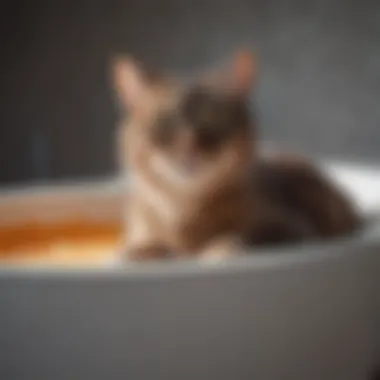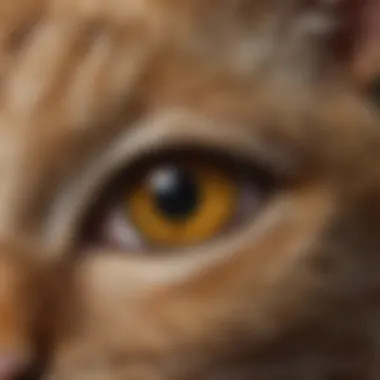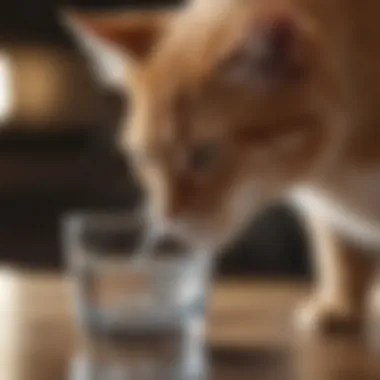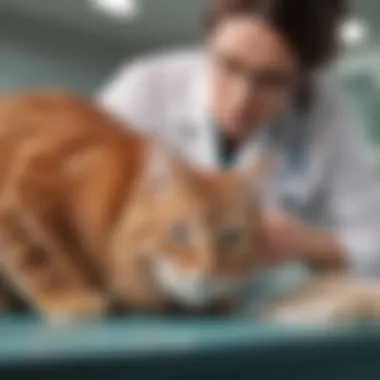Recognizing Signs of Urinary Tract Infection in Cats


Intro
For cat owners, the well-being of their furry companions is a top priority. One common health issue that can affect cats is a urinary tract infection (UTI). Understanding the telltale signs of a UTI can mean the difference between a quick diagnosis and potential complications. This guide dives into the various signals your cat might exhibit, providing you with the insights needed to recognize and address this condition promptly.
Feline biology is quite delicate. A UTI can lead to discomfort and may even escalate to serious health issues if left untreated. Therefore, it’s crucial for every cat owner to stay attuned to changes in behavior or habits.
Not all cats will display obvious signs of distress, so being observant is key. A cat's subtle cues can sometimes be overlooked amidst a busy life. Understanding these markers is vital to ensuring your pet's quality of life remains intact, allowing you to take necessary action without delay.
Let’s delve into how you can better understand your pet's needs and identify possible symptoms of a urinary tract infection.
Understanding Urinary Tract Infections in Cats
Understanding urinary tract infections (UTIs) in cats is pivotal for any cat owner. Knowing what a UTI is, recognizing its causes, and identifying the risk factors can help in spotting early symptoms, thus ensuring you don’t miss the boat when it comes to your cat’s health.
Definition of Urinary Tract Infection
A urinary tract infection occurs when harmful bacteria invade the urinary system of your cat, which includes the kidneys, bladder, ureters, and urethra. This condition can lead to inflammation, discomfort, and potentially more serious issues if not dealt with promptly. It’s not just a minor hiccup; a UTI can impact your feline’s overall quality of life. Symptoms can vary, but they generally include frequent urination or signs of pain while trying to go. If left untreated, complications can arise — which no pet owner wants to face.
Causes of Urinary Tract Infections in Cats
Understanding the causes narrows down the potential threat to your pet. A UTI can be triggered by several factors, including:
- Bacterial infection: The most common culprit. Bacteria from the skin or gastrointestinal tract may enter the urinary tract.
- Bladder stones: These can trap bacteria and create a perfect storm for infection.
- Poor hygiene: For indoor cats, especially, a lack of cleanliness can lead to infections.
- Compromised immune system: If a cat's immune system is not up to snuff, they are more vulnerable to infections.
- Urinary retention: Cats that don’t empty their bladders fully can have the bacteria linger, leading to an infection.
Addressing these causes can sometimes prevent a UTI before it starts.
Risk Factors for Developing a UTI
Not every cat is equally at risk of developing a UTI; certain conditions may put them in the danger zone. Here are some vital risk factors to keep an eye on:
- Age: Older cats often have weakened immune systems, making them more susceptible.
- Gender: Female cats are generally more prone to UTIs compared to males, though male cats face their own risks, primarily due to urinary blockages.
- Obesity: Overweight cats can have various health problems, including those that affect urinary function.
- Diet: A diet low in moisture can contribute to urinary tract issues. Ensuring your cat stays hydrated is key.
- Underlying Health Issues: Conditions like diabetes or kidney problems can make your feline friend more prone to UTIs.
By being aware of these key aspects, you set the stage for better prevention and quicker intervention. Early recognition and action can make a world of difference in your cat's recovery and overall health.
Recent studies indicate a direct correlation between diet and urinary tract health in cats.
Focusing on urinary health may not just help you avoid an unpleasant visit to the vet; it can keep your furry friend feeling their best.
Behavioral Signs to Observe
When it comes to your feline friends, behavior can say a lot more than just the usual purring or tail twitching. Recognizing the behavioral signs that may indicate a urinary tract infection is not just a matter of vigilance; it’s absolutely essential for timely intervention. A shift in your cat's behavior can be a crucial early warning sign, helping you catch a UTI before it escalates into a more serious health issue. Paying attention to these changes arms you with the knowledge to seek appropriate veterinary care, ensuring a quicker recovery for your pet.
Increased Frequency of Urination
If you see your cat making more trips to the litter box than usual, it could be a key indicator of a urinary tract infection. Normally, a cat may urinate several times a day, usually every 24 to 48 hours. However, a noticeable uptick might suggest discomfort or frustration as your cat attempts to relieve itself.


Increased urination often hints at inflammation. Some cats might urinate in smaller amounts more frequently, a behavior that can be distressing for both the animal and the owner. Take note of the timing—if your cat seems to go more often, particularly without releasing much urine, that’s a red flag worth investigating.
Straining while Urinating
Next, let’s discuss straining. If you catch your cat squatting and seemingly having to put in extra effort while trying to urinate, this might be a sign of a UTI. Sometimes, it may even lead to crying or meowing in distress. It’s deeply concerning to witness, and as a responsible pet owner, it should send you running to the vet's office.
Straining can also lead to blockages, especially in male cats. This situation could quickly become an emergency, so it is vital to keep a close eye on the litter box area. Any signs of struggle certainly call for immediate action.
Changes in Litter Box Habits
Litter box habits can serve as your cat's own personal diary. If your feline friend suddenly starts avoiding its litter box, or worse, having accidents outside of it, something is definitely amiss. Along with increased urgency, you may notice your pet appearing uncomfortable when it goes. Not only does this hint at a potential UTI, but it’s also a crucial insight into your pet's overall mood.
Cats thrive on routine, and any deviation from their established habits can signal underlying health issues. If you’re ever faced with this unusual behavior, don’t hesitate—tying it back to a possible UTI could save your cat from unnecessary suffering.
Excessive Grooming of the Genital Area
Lastly, let’s talk about grooming. Cats are known for their meticulous grooming habits, but if you observe your cat obsessively licking its genital area more than usual, it's time to pay attention. This behavior typically suggests irritation or discomfort, which could point to a UTI. The feline instinct to groom often kicks in when they’re trying to soothe an uncomfortable area.
While grooming is generally normal, excessive grooming can indicate that your cat is trying to alleviate some soreness or burning sensations associated with a urinary tract infection. If you notice this, don’t brush it off, as it could be the first sign of a more complex issue.
Paying attention to your cat's behaviors can help you spot health concerns early, bringing major benefits to its quality of life.
Physical Symptoms of UTI
Understanding the physical symptoms of a urinary tract infection (UTI) in cats is essential for any cat owner who wants to maintain their feline's health. While behavioral signs can hint at trouble, physical symptoms tend to be a clearer, more urgent call for veterinary support. Identifying these symptoms promptly can aid in swift diagnosis and treatment, thus preventing more serious health problems down the road.
Signs like blood in urine, foul-smelling urine, the presence of crystals, and vomiting can be alarming. They not only signal the potential pain the cat is experiencing but also suggest underlying issues that need addressing right away. By being observant and informed about these symptoms, you can take the necessary steps to ensure your cat receives appropriate care.
Blood in Urine
Seeing blood in your cat's urine is a troubling sign and cannot be overlooked. This phenomenon, known medically as hematuria, can occur due to a UTI but can be linked to other significant health issues, like kidney stones or tumors. If you notice that your cat's litter box is splattered with red-tinged urine, it’s time to act.
It's critical to closely observe your cat during bathroom breaks. Pay attention to any changes in urine color and look for patterns— like if the blood is persistent or if it appears suddenly. Some cats may only pass blood during urination, while others might excrete blood intermittently. Regardless of the pattern, blood in the urine signals distress, and veterinary advice should be sought promptly.
Foul-Smelling Urine
Another symptom that indicates a possible urinary tract infection is foul-smelling urine. Foul odors can arise from a variety of factors, including infections that lead to the breakdown of bodily waste products. The smell might even have a strong, ammonia-like quality, indicating an underlying bacterial presence.
When your cat's urine scent shifts from its usual delicate aroma, it’s a red flag that something is amiss. While you might think this could be just a few bad cat litter days, if the odor persists, professional evaluation is needed. Cats are generally clean creatures; a sudden change in odor can be alarming and deserves attention.
Presence of Crystals in Urine
The appearance of crystals in your cat's urine is a more complex issue and can be associated with several urinary problems, including UTIs. These crystals can form when minerals in the urine become concentrated, often due to dehydration or dietary issues.
When examining your cat's litter, a granular texture or visible particles in the urine can indicate the presence of urinary crystals. Common types include struvite and calcium oxalate crystals, both of which can lead to severe health complications if ignored. Addressing crystalluria often involves dietary changes and increased water intake, but identifying the crystals early on can prevent acute issues.
Vomiting and Loss of Appetite


Lastly, vomiting and a diminished appetite are tell-tale symptoms that often accompany urinary tract infections. Cats can exhibit these signs for various reasons, but if they coincide with other symptoms, they may indicate that your cat is dealing with a UTI.
A cat that suddenly turns up its nose at food or begins to lose weight may be experiencing significant discomfort. Vomiting, particularly if it’s frequent, can lead to dehydration—a dangerous condition that maches with the urinary issues. Keep an eye out for both of these symptoms as they warrant immediate veterinary consultation.
The sooner symptoms like vomiting and changes in appetite are recognized, the faster your cat can get the care it needs.
In summary, physical symptoms of urinary tract infections in cats can be distressing indicators of underlying health problems. Keeping a vigilant eye on your feline friend's health and behaviors can make all the difference in prompt diagnosis and treatment. Understanding these symptoms helps ensure your cat gets back to purring happily alongside you.
Emotional and Social Changes
When it comes to urinary tract infections (UTIs) in cats, the emotional and social changes that your pet exhibits can serve as crucial indicators of health. Unlike humans, cats are often masterful at hiding their discomfort, making it even more vital for pet owners to be observant. A shift in your cat's behavior can signal something amiss, and understanding these changes can lead to timely interventions, ultimately preserving your feline's well-being.
Signs of Discomfort or Pain
One of the most telling signs your cat might be facing a UTI is discomfort or pain, which often manifests in physical behaviors. You might notice your cat squinting its eyes, tail twitching, or even a refusal to sit down comfortably. When cats are in pain, they sometimes display a "fidgety" disposition, pacing around the house or seeking solitude. Paying attention to how your pet moves around can be essential. A normally agile cat might struggle with activities it once found easy, like jumping onto the bed or litter box.
Often, they may vocalize more than usual. You could hear them yowling or making other unusual sounds when they are trying to relieve themselves, which can be quite distressing.
Withdrawal from Interaction
Social withdrawal is another critical sign your kitty might be suffering from a urinary tract infection. Cats are typically social creatures, seeking your company for cuddles or play. If your usually affectionate cat suddenly prefers hiding under the bed or retreating to a dark corner, it is a signal to pay heed.
This withdrawal can also extend to their playful nature. You might find them ignoring toys that once captivated their attention. This change in social engagement can stem from discomfort, making them less inclined to interact.
"Cats are complex animals, and their emotional states can be a mirror to their physical health. A sudden shift in behavior warrants a deeper look into their well-being."
Restlessness or Excessive Vocalization
Lastly, restlessness or excessive vocalization could shed light on their emotional state when a urinary tract infection is present. An agitated cat may seem unable to settle, moving around the house aimlessly or consistently changing positions.
Excessive meowing or more chaotic sounds can reveal a level of distress or anxiety. They often don’t vocalize just for attention; rather, it’s their way of expressing their discomfort. Listening carefully can help detect patterns or changes in sound frequency and intensity, giving you deeper insights into your cat's condition.
Understanding these emotional and social changes is paramount. Being alert to them allows you to intervene early, preventing the simple discomfort of a UTI from escalating into a more serious issue. Recognizing these signs can lead you to seek veterinary care sooner, ensuring your cat’s comfortable life remains just that—a life full of comfort and joy.
When to Seek Veterinary Attention
Recognizing when to seek veterinary attention for your cat can make all the difference in a swift recovery from a urinary tract infection (UTI). Prompt intervention not only helps alleviate your pet's discomfort but also prevents potential complications that can arise from untreated infections. It's essential to pay close attention to the behavioral and physical signs previously discussed, but knowing when these signs indicate an emergency situation is crucial.
Recognizing Emergency Symptoms
When observing your feline friend, certain symptoms should ring alarm bells. Here are some clear indicators:
- Inability to Urinate: If your cat is straining in the litter box and no urine is produced, this is a serious situation. It can lead to serious bladder damage and even kidney failure if not addressed urgently.
- Severe Blood in the Urine: Spotting blood is alarming, but when it’s accompanied by distress or lethargy, you shouldn't hesitate to consult your vet.
- Excessive Vomiting: If your cat is vomiting, especially alongside other symptoms like lethargy or loss of appetite, it’s a signal that their body may be in distress.
- Fever: A sign of infection or inflammation, a fever can often indicate a more serious underlying condition.
- Unresponsive Behavior: If your cat is non-responsive or unusually lethargic, their health may be at risk, requiring immediate veterinary care.
These signs suggest that your cat may be facing a severe UTI or another medical emergency. A timely trip to the vet can prevent worsening of the overall condition.


Understanding the Dangers of Delayed Treatment
Delaying veterinary care can have grave consequences. When a UTI goes untreated, the infection can escalate, potentially spreading to other parts of the urinary system, or even worse, to the kidneys. Here’s a closer look at the possible ramifications:
- Formation of Crystals or Stones: An untreated UTI can result in urinary crystals or stones, leading to obstruction and extreme discomfort.
- Kidney Damage: The kidneys can become affected if the infection travels upward. This can result in irreversible kidney damage or chronic issues.
- Increased Costs: Prompt treatment often leads to easier and less expensive solutions. Delaying can escalate the problem and result in extensive medical interventions that can strain your budget.
"Take into account that your cat cannot articulate its discomfort. Be proactive in understanding its body language and signs of distress."
By knowing when to act quickly, you are also contributing greatly to your pet's overall well-being. Keep your vet's contact information handy, and don’t be shy to reach out when in doubt. Your quick response can lead to better outcomes.
Preventive Measures and Management
Preventing urinary tract infections (UTIs) in cats is more than just a good practice; it’s a vital aspect of ensuring your feline friend's overall well-being. By implementing certain preventive measures and management strategies, cat owners can help reduce the risk of UTIs and avoid the discomfort these infections can cause. Let's look closely at some essential elements, the benefits, and considerations involved.
Hydration and Diet Changes
Keeping your cat well-hydrated can make a world of difference when it comes to urinary health. Cats, by nature, often don’t drink enough water. Here’s how you can encourage better hydration:
- Fresh Water Access: Always provide fresh, clean water. Change it frequently to keep it appealing.
- Wet Food Benefits: Consider incorporating wet food into their diet. It contains more moisture compared to dry kibble and supplements their water intake, which may help dilute urine.
- Flavors and Variety: Sometimes, a little variety goes a long way. Try different flavors or add a splash of low-sodium broth to dry food to entice your cat to drink more.
In addition to hydration, be sure to pay attention to their diet. Certain foods can influence urine pH levels, which is crucial because an imbalance can lead to the development of stones and consequently UTI. Talking to a veterinarian about diet options tailored for urinary health is a prudent step.
Regular Veterinary Check-Ups
Prevention is always better than cure, and regular veterinary check-ups are crucial. Just like humans, cats benefit greatly from scheduled health assessments. During these visits, vets can:
- Monitor Health Trends: They can keep an eye on your cat's weight, hydration level, and overall health, picking up on potential issues early.
- Urine Tests: Regular urine tests can screen for anything unusual, including infection signs or crystals that could lead to problems down the line.
- Vaccinations and Treatments: Ensure that vaccinations are up to date, as some can help prevent diseases that can cause UTIs.
It’s wise to maintain an open line of communication with your vet. Don’t hesitate to discuss any behavior or health changes in your cat, as these could point toward underlying problems.
Environmental Modifications
Your cat’s environment plays a significant role in their health. Making simple adjustments can help minimize the risk of UTIs. Here’s what you can do:
- Litter Box Maintenance: Be diligent about keeping the litter box clean. Cats can be picky about hygiene; a dirty box might deter them from going, leading to issues.
- Multiple Litter Boxes: If you have several cats, ensure there are enough boxes available—ideally, one per cat plus one extra. This reduces territorial stress and makes it easy for them to relieve themselves when needed.
- Safe Spaces: Provide safe and quiet areas for your cat to relax. Stress can affect their overall health and lead to behaviors that predispose them to UTIs.
"Consistency in your cat’s environment can promote a sense of security, which is essential in reducing anxiety-related health issues."
Epilogue
Recognizing the factors that indicate your cat is suffering from a urinary tract infection is of paramount importance for the overall health and well-being of your feline friend. The signs discussed throughout this article— ranging from behavioral changes to physical symptoms—serve as critical indicators for pet owners. When one pays close attention to these signs, quick action can be taken, potentially preventing more serious complications that may arise from a UTI.
Summarizing Key Takeaways
To summarize the essential points:
- Behavioral Observations: Increased frequency of urination, straining, and changes in litter box habits are significant signs that something may be amiss.
- Physical Symptoms: Blood in urine and unusual foul odors are take notice indicators that cannot be ignored.
- Emotional Changes: Signs of discomfort and social withdrawal are often overlooked but are vital signals of distress.
Gathering these observations can empower cat owners to take proactive steps in addressing a UTI.
Encouraging Responsible Pet Care
Caring for pets involves a responsibility not only to keep them fed and sheltered but also to ensure their health is continuously monitored. Regular vet check-ups, adjustments to their diet, and attentive observation of their behavior can make a significant difference in early detection. When you prioritize your cat's health, the bond between you strengthens, and you ultimately contribute to their long-term happiness and well-being. Don't underestimate the power of knowledge—having the right information can greatly enhance your ability to care for your beloved pet.



